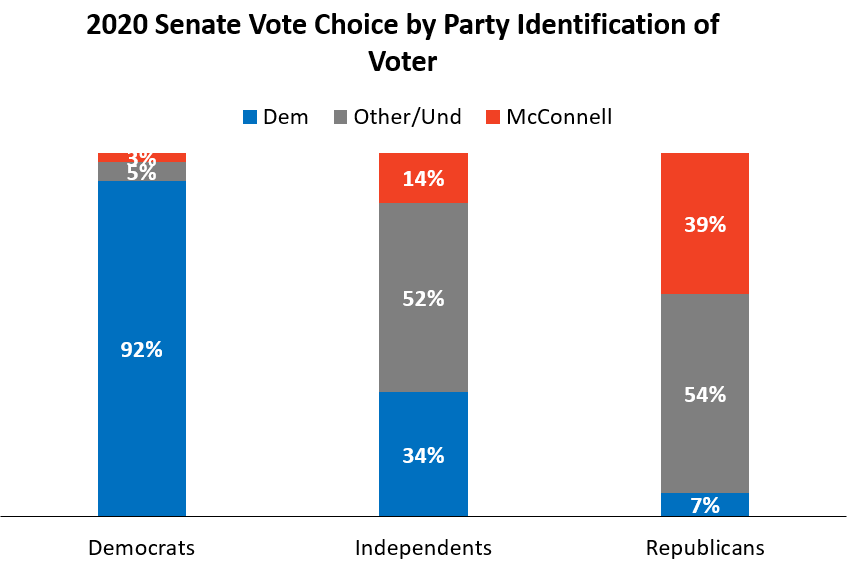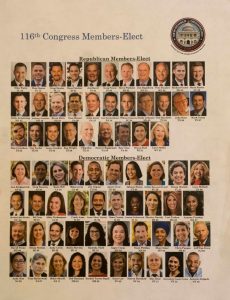Ronald Brownstein addresses the question of the hour for Democrats: “Can Democrats Bend Their New Coalition Without Breaking It? The voters who flipped the House aren’t uniformly on board with an ambitious progressive agenda” at The Atlantic: “Though they’ve attracted little attention, recent public polls have sent clear warning signals that the ambitious agenda of the rejuvenated Democratic left could strain the coalition that carried the party to its sweeping gains in the 2018 election…Recent surveys show that such prized progressive ideas as a government-run single-payer health-care system, tuition-free public college, and significantly higher top marginal income-tax rates hold the potential to starkly divide Democrats along racial lines. In polls, these policies have faced substantial skepticism not only from working-class white voters already drawn to President Donald Trump, but also from college-educated whites, whose recoil from him powered last fall’s Democratic wave in white-collar suburbs around the country. Support for these ideas is consistently higher among African Americans and Latinos, though in some cases equivocal even among them…These findings underscore the stakes in the rolling Democratic debate about the best pathway for the party to oust Trump in 2020, particularly as his job-approval rating ticks up in several polls amid broadening satisfaction with the economy.”
Brownstein quotes Adam Green, the co-founder of the Progressive Change Campaign Committee, which has endorsed Warren for the Democratic nomination. “We need an equal and opposite willingness to shake things up, but in the right way,..Part of the case that progressives will make is not only is there zero tension between electability and bold transformational ideas, but bold transformational ideas that shake up the system are absolutely key to electability against Trump…Meanwhile, centrists attracted to candidates such as former Vice President Joe Biden and Senator Amy Klobuchar insist that Democrats must find a nominee and formulate an agenda that holds the support of swing voters, who are contented with the economy and may support some of Trump’s economic policies, but dislike his views on race and culture and find him personally unfit for the presidency. “You will never beat him on just turnout, because he does as good or a better job of [inspiring] turnout,” says John Anzalone, a longtime Democratic pollster who has advised Biden. “So you have to do both. You have to do great turnout with your base and also appeal with independents.”
Further, adds Brownstein, “The 2018 results offered evidence for both approaches. The big Democratic gains were driven by much-improved turnout, compared with the 2014 midterms, among young people and minorities; a substantial improvement in vote share among college-educated white voters, especially women; and a smaller recovery among working-class whites, especially in the key Rust Belt battlegrounds of Pennsylvania, Michigan, and Wisconsin. While self-described independent voters narrowly preferred Trump over Hillary Clinton in 2016, Democratic House candidates carried those voters by double digits in 2018, according to network exit polls.” Brownstein cites “a fundamental fault line in a modern Democratic coalition that’s more and more dependent on upscale white voters, who are drawn to the party more for its views on cultural than economic issues” and notes, “Voters have repeatedly demonstrated that if they believe presidential candidates care about their lives, they are willing to overlook disagreements over important components of their agenda—or even, as in Trump’s case in 2016, serious doubts about their character and temperament.”
In “The Rise of White Identity Politics: White voters increasingly see themselves as a threatened ethnic group. By championing an inclusive American identity, liberal politicians can offer an alternative” at The Washington Monthly, Richard D. Kahlenberg takes a look at Duke University political scientist Ashley Jardina’s book, White Identity Politics, and explains, “Trump’s election sparked a furious debate on the left: was his popularity among white voters due more to racism, or to so-called “economic anxiety”? Extensive polling showed that racial resentment correlated much more strongly with support for Trump than did economic factors. But could tens of millions of Trump voters really be out-and-out racists?..Jardina’s book helps make sense of these questions, in part by revealing that white voters can be motivated by race without necessarily being motivated by racism. The traditional social science focus on white hostility and prejudice toward out-groups, Jardina suggests, misses a much bigger phenomenon: in-group white identity and favoritism. Her central finding is that while 9 percent of whites are unabashed racists who hold favorable views of the Ku Klux Klan, a much larger group—between 30 to 40 percent of whites—strongly identify as white, meaning they feel strong attachment to their whiteness. Whites who have high levels of white identity are not confined to the working-class; they make up a “much wider swath of whites,” and perhaps surprisingly, include a disproportionate number of women.”
“This demographic shift,” Kahlenberg continues, “is occurring at a time when whites remain deeply opposed to programs that provide preferences in college admissions and employment for African Americans and Latinos. A February 2019 Pew Research Center poll found that 78 percent of whites (and 73 percent of Americans overall) think race should not be a factor in college admissions decisions. Universities routinely ignore that public sentiment. Careful researchers find that such programs provide a college admissions boost for African Americans over whites that is comparable to scoring 310 points higher on the SAT (out of a possible 1600). The sociologist Arlie Hochschild has documented thatwhites often described these types of preferences as allowing non-white groups to “cut in line.” Perceived as unfair, these programs—as well as other government efforts viewed, rightly or wrongly, as providing targeted aid to minority groups— can trigger white identification. In surveys, three-quarters of whites say it is at least somewhat likely that “members of their racial group are denied jobs because employers are hiring minorities instead.” More than three-quarters also say it is at least somewhat important “for members of their group to work together in order to change laws unfair to whites.” In sum, Jardina notes, “many whites have described themselves as outnumbered, disadvantaged, and even oppressed.”
At FiveThirtyEight, Nathaniel Rackich has developed a new statistical tool to illuminate the political context of U.S. Senate races: “PARS [Popularity Above Replacement Senator]…is calculated by measuring the distance between a politician’s net approval rating (approval rating minus disapproval rating) in her state and the state’s partisan lean (how much more Republican- or Democratic-leaning it is than the country as a whole).” Rakich uses the tool to look at Majority Leader Mitch McConnell’s senate race, and writes, “Finally, the senator who ranks last in PARS is also up for reelection in 2020, and it’s a big name: Majority Leader Mitch McConnell. McConnell manages just a -13 net approval rating despite inhabiting an R+23 state. It’s not crazy to think he could be vulnerable in 2020. Democrats are reportedly trying to recruit former Marine fighter pilot Amy McGrath, who raised $8.6 millionfor an unsuccessful 2018 congressional bid, to run against him. But it’s worth remembering that Lucy has held this football in front of Democrats before. In 2014, McConnell also had popularity problems, and Democrats thought they had a top candidate to challenge him in Secretary of State Alison Lundergan Grimes. McConnell beat Grimes 56 percent to 41 percent.” Rakich provides a chart showing the ratings for every U.S. senator.
Democratic frontrunner Joe Biden is making a strong bid for working-class voters of all races, as evidenced by his pitch yesterday to Teamsters Local 149 in Pittsburgh. As Kevin Breuninger reports at CNBC: “Biden — speaking to a crowd filled with union members — steered his remarks heavily toward populist issues including corporate greed and income inequality….”I make no apologies — I am a union man. Period,” said Biden, who had received his first union endorsement earlier that morning….”The country wasn’t built by Wall Street bankers, CEOs and hedge fund managers,” Biden told the crowd. “It was built by you. It was built by the great American middle class.”…”We need to reward work in this country, not just wealth,” Biden said…The early days of the former Delaware senator’s campaign strategy appear to be aimed at shoring up his support in Pennsylvania, a swing state rich in electoral votes that former Secretary of State Hillary Clinton narrowly lost to Trump in the 2016 election.”
William Saletan argues that Dems should “Trust Pelosi” at Slate: “The smarter play, in Pelosi’s view, is to defend policies that are well understood and supported. Let your enemy be the aggressor, and rally your base against his attack. Instead of pushing Medicare for All, the speaker targets President Donald Trump’s assault on the Affordable Care Act. She specifies elements of the ACA that score well in polls: “protections against pre-existing conditions, bans on lifetime limits and annual limits, the Medicare-Medicaid expansion, savings for seniors on their prescription drugs, [and] premium assistance that makes health coverage affordable.”…Pelosi understands that Trump is just a foil. The real goal is to build a relationship with voters. Contrary to perception, she hasn’t ruled out impeachment. But she does think Democrats should talk less about Trump and more about connecting with the public…Some critics see Pelosi’s centrist language as weak and uninspiring. But she cares about policies, not ideologies, so she’s ruthless about embracing or shedding labels. She believes, for instance, that fairness is a more popular and less incendiary term than socialism.,,A party can win more votes, in Pelosi’s view, by claiming to represent the middle than by claiming to represent a wing or a movement. “The Republicans have abandoned the center. The left can own it,” she argued on Tuesday.”
In his article, “Racism on the brain: a neuroscientist explains how the world moved right: The effects of fear and anger [on the brain]” may make us even more polarized, says neuroscientist Bobby Azarian,” at Salon.com, Chauncey Devega interviews congnitive neuroscientist Bobby Azarian, who observes “In a healthy functioning brain, an area called the prefrontal cortex, which is slower acting, slows the amygdala response and in essence says to a person, “hey, there’s no rational reason to fear this or to feel angry.” One could really conclude that explicit racism is often the result of an impaired prefrontal cortex response. Understanding racism on the neural level is very important…It is in the realm of science fiction now, but someday in the future, 10, 20 [years] from now, we might be able to identify [the] pathways or abnormalities in the brain which [are] responsible for some of that nasty behavior such as racism and the like…Donald Trump and Steve Bannon understood the psychological effects of fear and they weaponized it to take power. Consider the Facebook Cambridge Analytica data scandal, where data got into the hands of Bannon [who] used it to manipulate voters. With Trump’s campaign, it seems like they perfected the a strategy of fear mongering to manipulate people into some other type of reality…As more and more damning information comes out about Trump, the public will be able to check their biases and assess the situation more rationally and reasonably. That is my hope for the future.”








